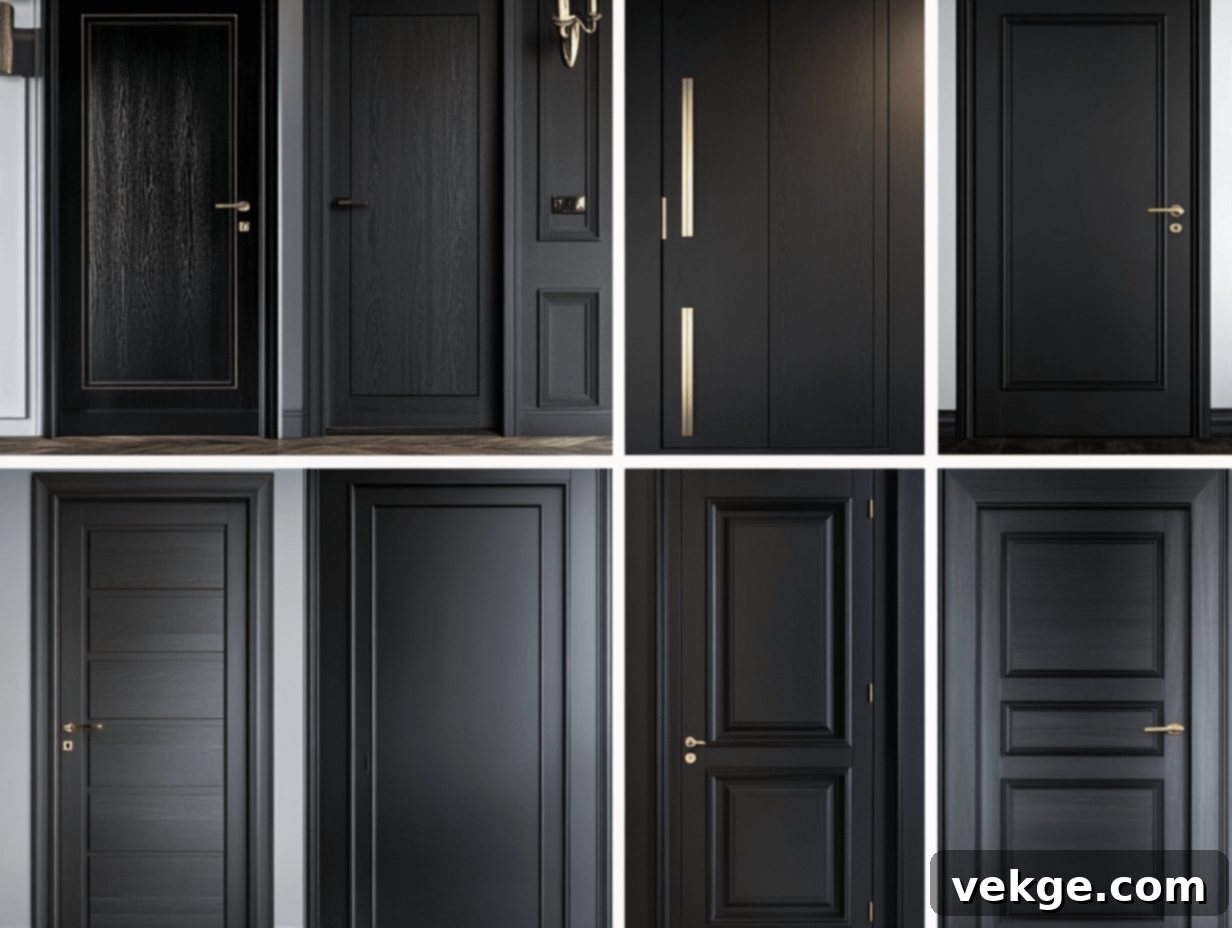The Ultimate Guide to Black Interior Doors: Best Paints, Finishes & Care Tips
Black interior doors are a powerful trend, transforming homes with their bold, stylish, and unexpectedly versatile appeal. Whether your aesthetic is modern, classic, or elegantly eclectic, painting your interior doors black is a design choice that makes a significant statement. However, navigating the vast array of black paint options to find the perfect shade and finish can feel daunting.
This comprehensive guide is designed to simplify that process, providing you with everything you need to know. We’ll delve into:
- Expert picks for the 15 best black paints, detailing their unique characteristics and ideal applications.
- Simple, step-by-step tips for achieving a flawless paint application.
- Essential advice on maintaining your stunning black doors to ensure they look impeccable for years to come.
By the time you finish reading, you’ll possess the confidence and knowledge to seamlessly select, apply, and care for black paint, achieving that sought-after sleek and polished look for your interior doors. I’ve leveraged years of experience to compile this guide, making your decision-making process easy and effective. Let’s solve your paint dilemma together and unlock the transformative power of black doors in your home.
Why Choose Black Paint for Interior Doors? A Timeless & Practical Choice
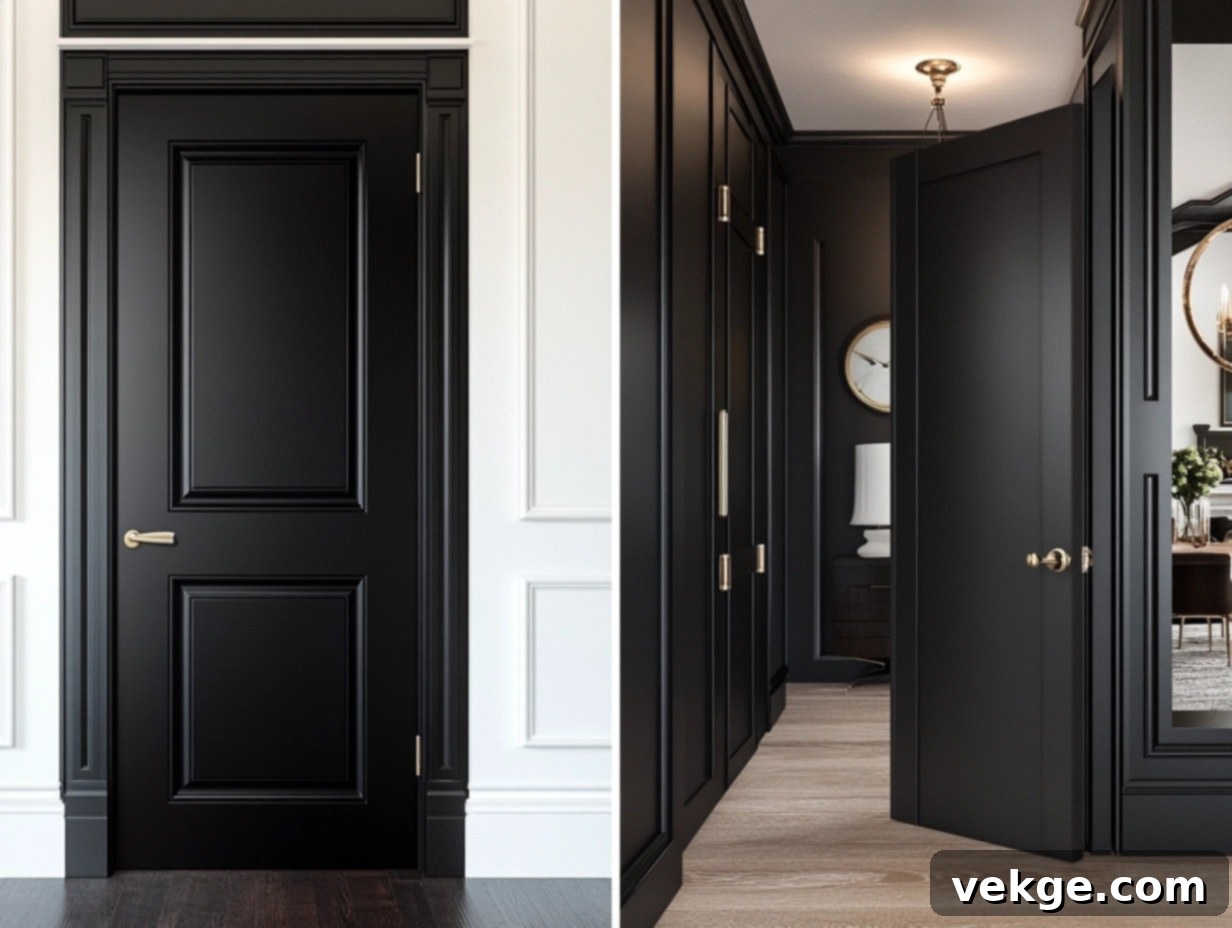
The allure of black doors first captivated me years ago while renovating my initial home, and their impact remains undeniable. They possess a unique ability to dramatically elevate a space, making a powerful style statement without extensive overhauls. Here’s why black interior doors make such a significant difference and why they’ve become a favorite among designers and homeowners alike:
Black Creates Striking Contrast: Imagine crisp, light-colored walls or subtly textured wallpaper. Black doors instantly pop, creating a sophisticated visual contrast that defines spaces and adds depth. They act as natural focal points, drawing the eye and making even the simplest room feel more intentional and cohesive. I’ve witnessed countless plain rooms come to life with this single, impactful change. Think of black doors not just as functional elements, but as architectural artwork. They beautifully frame each room’s entrance, providing a sense of order and structure, especially against light walls.
Unmatched Versatility: Black isn’t just a color; it’s a timeless design element. It effortlessly integrates into virtually any decor style. From the rustic charm of a farmhouse to the sleek lines of a modern loft, the intricate details of a traditional home, or the artistic flair of an eclectic space – black doors adapt and enhance. This universal appeal ensures your design remains relevant and chic for years to come.
Practicality You’ll Appreciate: Beyond their aesthetic appeal, black doors offer remarkable practical benefits that many people overlook. They are incredibly forgiving in busy households:
- They effectively hide everyday scuffs, minor marks, and fingerprints far better than lighter colors.
- Small chips or imperfections are significantly less noticeable, maintaining a pristine appearance.
- Cleaning is a breeze – a simple wipe with a damp cloth is often all that’s needed to keep them looking fresh.
- Unlike white doors, they don’t show dirt and dust as quickly, meaning less frequent deep cleaning.
Budget-Friendly Transformation: While many home updates can cost thousands, painting your interior doors black is an exceptionally budget-friendly way to achieve a high-end, custom look. With just a few cans of paint, you can entirely transform the ambiance of your home, delivering premium aesthetics without the premium price tag.
Enhances Spatial Perception: I’ve also observed that black doors can make small spaces feel more grounded and organized. They provide visual anchors, giving your eyes a place to rest and contributing to a more “finished” and thoughtfully designed feel within a room. This subtle psychological effect can make your home feel more curated and inviting.
The best part? You truly can’t go wrong with black. Its enduring popularity ensures it never goes out of style, making it a perennial favorite among my clients and a wise, lasting choice for your home.
Best Black Paints for Interior Doors: Expert Recommendations
Choosing the perfect black paint is crucial for achieving the desired effect. Here are my top 15 expert-recommended black paints, each offering unique qualities to suit various styles and needs.
1. Benjamin Moore’s Black Beauty (2128-10)
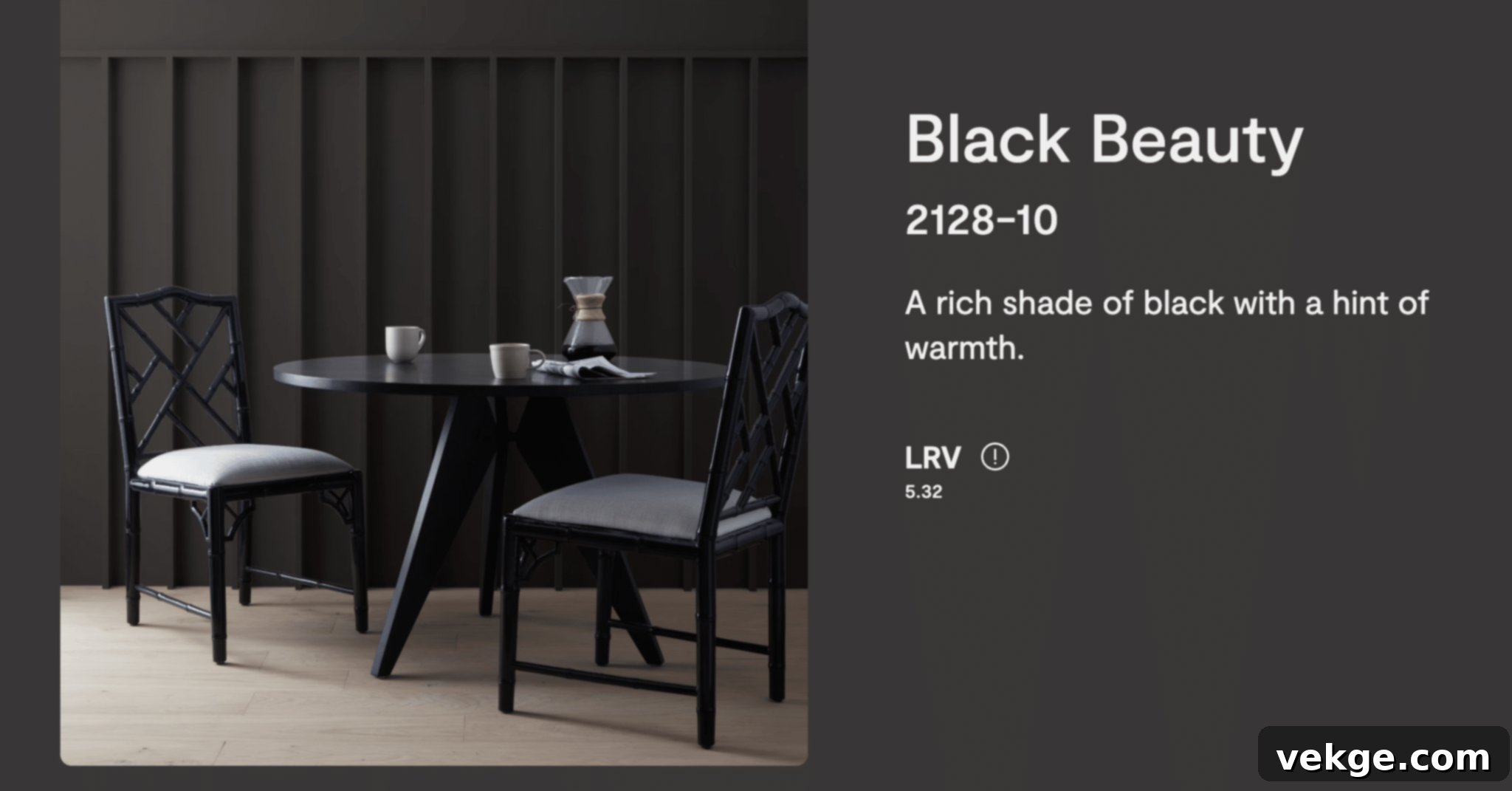
This shade stands out for those seeking a deep, velvety black that imparts an immediate sense of luxury and sophistication in any setting. It’s a timeless choice that feels both classic and contemporary.
Features
- Rich, Neutral Black: A perfectly balanced shade that works seamlessly in both modern minimalist and elaborate traditional designs.
- Velvety Finish: Its subtle sheen helps to minimize the appearance of minor imperfections on door surfaces, creating a smooth, refined look.
- Durable Formula: Engineered to resist scuffs and scratches, making it an excellent choice for high-traffic areas like entryways and hallways.
Best For: Timeless spaces requiring an elegant, sophisticated touch that can transition through various design evolutions. Explore Benjamin Moore Black Beauty here.
2. Sherwin-Williams Tricorn Black (SW 6258)
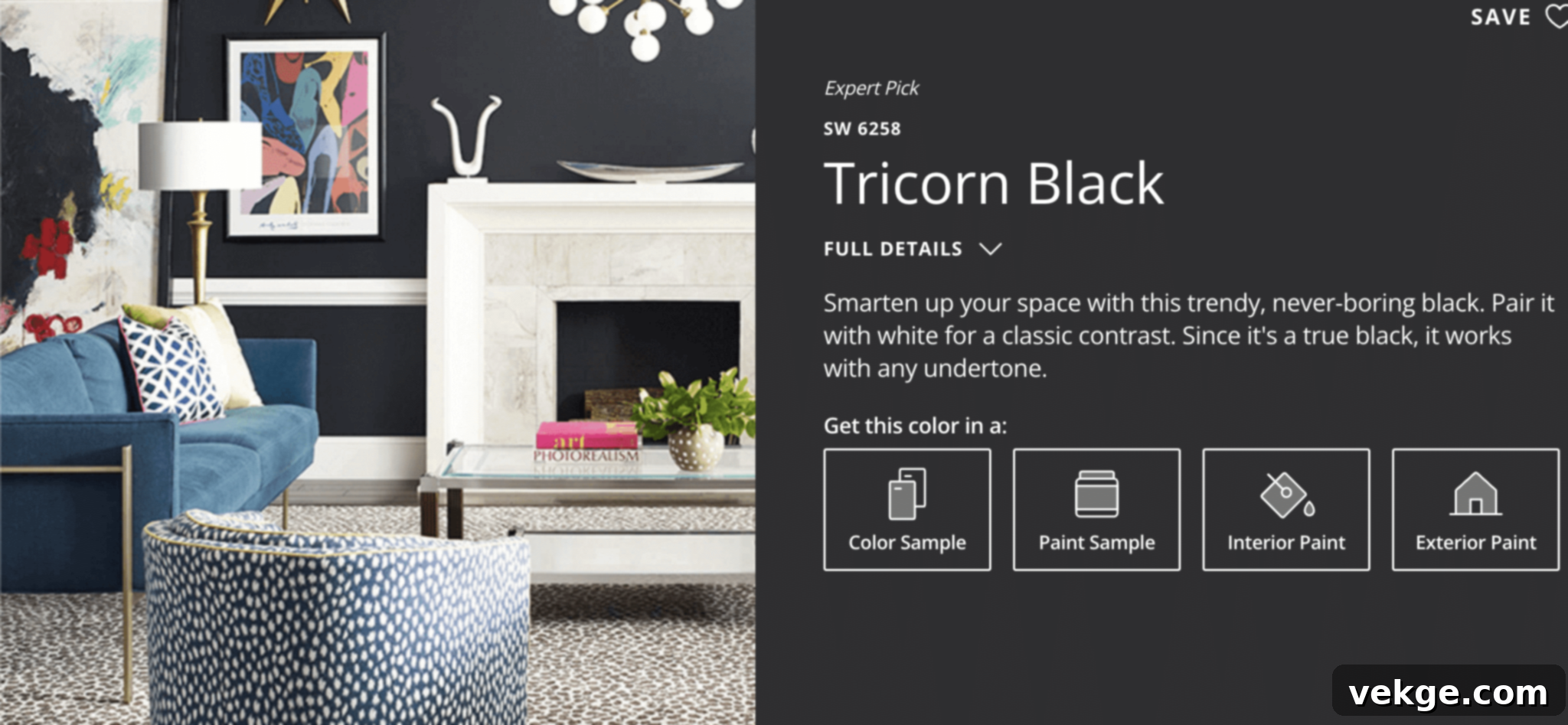
A true, neutral black, Tricorn Black is celebrated for its incredible versatility and adaptability. It’s often hailed as the “perfect” black because of its lack of discernible undertones.
Features
- Pure Black: Absolutely no undertones of blue, brown, or green, ensuring it maintains its true black appearance under various lighting conditions.
- Excellent Coverage: Its high pigment saturation often means fewer coats are needed, saving time and paint.
- Finish Versatility: Compatible with various finishes, allowing you to choose anything from a sleek high-gloss to a subtle matte, tailoring the aesthetic to your exact preference.
Best For: A classic, foolproof option that complements both bold statement styles and understated, subtle decors. It’s a go-to for designers seeking a reliable pure black. Discover Sherwin-Williams Tricorn Black.
3. Farrow & Ball Pitch Black
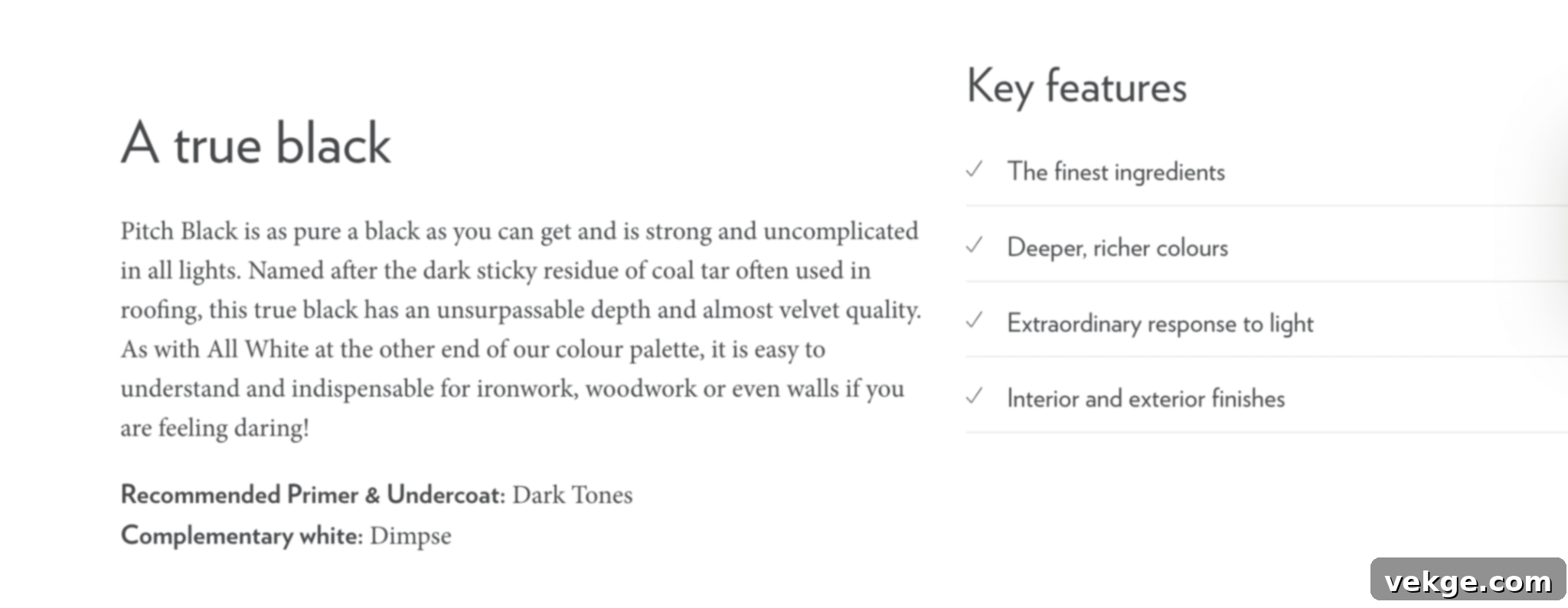
Farrow & Ball Pitch Black is a premium choice designed for homeowners who wish to make a distinctly luxurious and dramatic statement. Its depth is unparalleled.
Features
- Deep, Rich Black: Offers an intense, almost inky black hue with a signature matte finish that lends itself to a sophisticated, high-end appearance.
- Eco-Friendly Formula: Formulated with low VOCs (Volatile Organic Compounds), making it a safer and more environmentally conscious option for indoor use.
- Exceptional Opacity: Provides smooth, even coverage that hides underlying colors effectively, achieving a uniform finish.
Best For: Elegant spaces or upscale interiors that demand a bold, dramatic, and truly luxurious finish. It’s perfect for creating a gallery-like atmosphere. Learn More about Farrow & Ball Pitch Black.
4. Behr Premium Plus Limousine Leather (MQ5-05)

An affordable yet reliable choice, Limousine Leather presents a soft black that’s a practical and versatile option for a wide range of households and design preferences.
Features
- Soft Black Tone: A gentler black that offers great versatility, available in both matte and semi-gloss finishes to suit different desired effects.
- Stain-Blocking & Mildew-Resistant: Its advanced formula includes properties that enhance durability, making it ideal for active areas and potentially humid environments.
- Easy Application: Designed for smooth application, resulting in a professional-looking finish even for DIY enthusiasts and beginners.
Best For: Budget-friendly updates in casual, family-friendly spaces where durability and ease of application are key. Explore Behr Premium Plus Limousine Leather (MQ5-05).
5. Valspar Cracked Pepper (CI55)
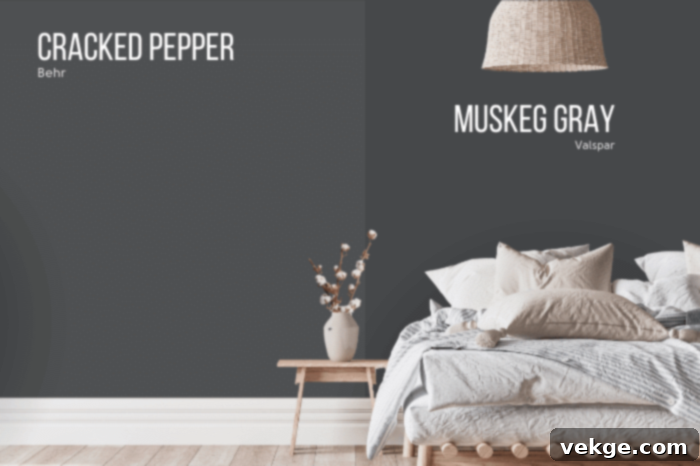
This unique shade of black has subtle gray undertones, making it perfect for creating sophisticated, understated, and contemporary designs that require a touch of softness.
Features
- Gray Undertones: The hint of gray creates incredible depth and softness, preventing the black from feeling too stark, making it ideal for rooms with abundant natural light.
- Excellent Durability: Engineered to hold up well in both low- and high-traffic areas, offering reliable performance throughout your home.
- Versatile Pairing: Harmonizes beautifully with neutral and cool-toned color palettes, enhancing a serene and modern aesthetic.
Best For: Minimalist interiors or spaces that benefit from an understated contrast, providing elegance without overwhelming the room. Currently no direct product link, but widely available.
6. Dunn-Edwards Black DE 6359
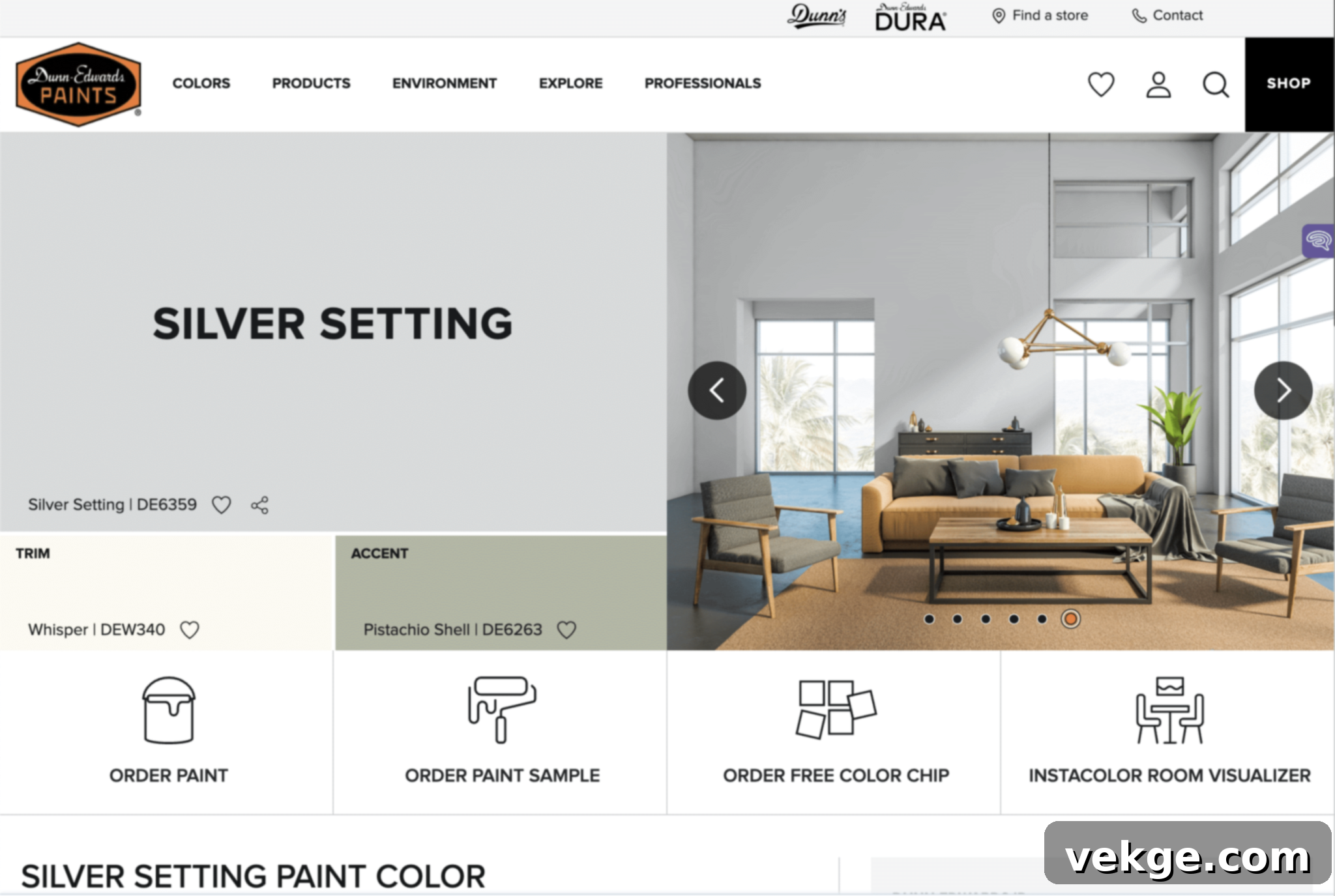
A distinguished semi-gloss option, Dunn-Edwards Black DE 6359 is specifically formulated for long-lasting durability and superior practicality, making it a smart choice for busy homes.
Features
- Semi-Gloss Finish: This finish not only provides a sophisticated sheen but is also exceptionally easy to clean and highly resistant to scuffs and marks.
- Long-Lasting Durability: Designed to withstand the rigors of high-use doors and trims, maintaining its fresh appearance for an extended period.
- High-Opacity Formula: Requires fewer coats to achieve full, rich coverage, saving time and ensuring a smooth, even application.
Best For: High-traffic areas such as kitchens, bathrooms, laundry rooms, or hallway doors where cleanliness and resilience are paramount. Check Out Dunn-Edwards Black DE 6359.
7. Rust-Oleum Chalked Black
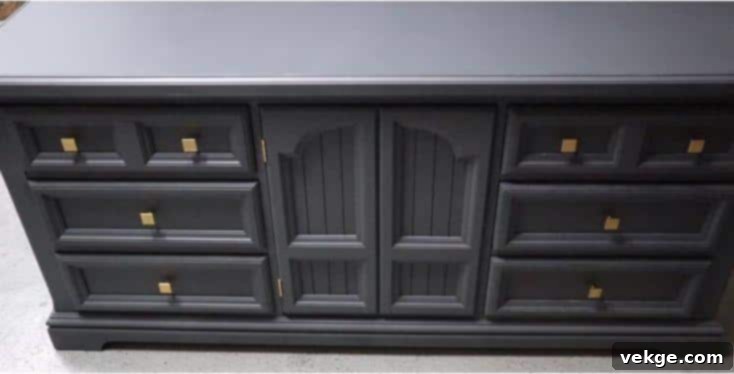
If you’re aiming for a vintage or rustic aesthetic, Rust-Oleum Chalked Black is the ideal choice, offering a distinctive ultra-matte finish that exudes character and charm.
Features
- Ultra-Matte, Chalky Finish: Delivers a unique, soft, and powdery finish that is perfect for creating a distressed, antique, or shabby-chic look.
- Easy to Distress: Its formulation allows for simple sanding and distressing, giving you the ability to personalize and achieve a beautifully worn effect.
- Quick-Drying Formula: Ideal for fast-paced projects, suitable for use on wood and other porous surfaces often found in vintage furniture or doors.
Best For: Rustic, farmhouse, or shabby-chic designs that benefit from a touch of history and personalized character. Find Out More about Rust-Oleum Chalked Black.
8. PPG Black Magic (PPG1001-7)
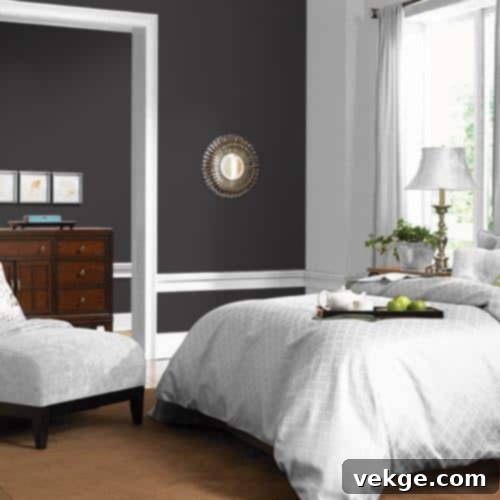
A bold and dramatic black, PPG Black Magic offers excellent performance and impressive durability, ensuring your doors maintain their striking appearance for a long time.
Features
- Fade-Resistant Formula: Specifically designed to maintain its deep, rich vibrancy, resisting fading even in areas with some sun exposure.
- Smooth Application: Engineered for easy brush and roller application, resulting in minimal brush marks and a consistently smooth finish.
- Interior & Exterior Versatility: Suitable for both interior and exterior doors, offering cohesive design possibilities throughout your property.
Best For: Creating bold statement doors in contemporary settings or dramatic, elegant spaces where longevity and color retention are priorities. View the PPG Black Magic Product Page.
9. Dutch Boy Iron Black
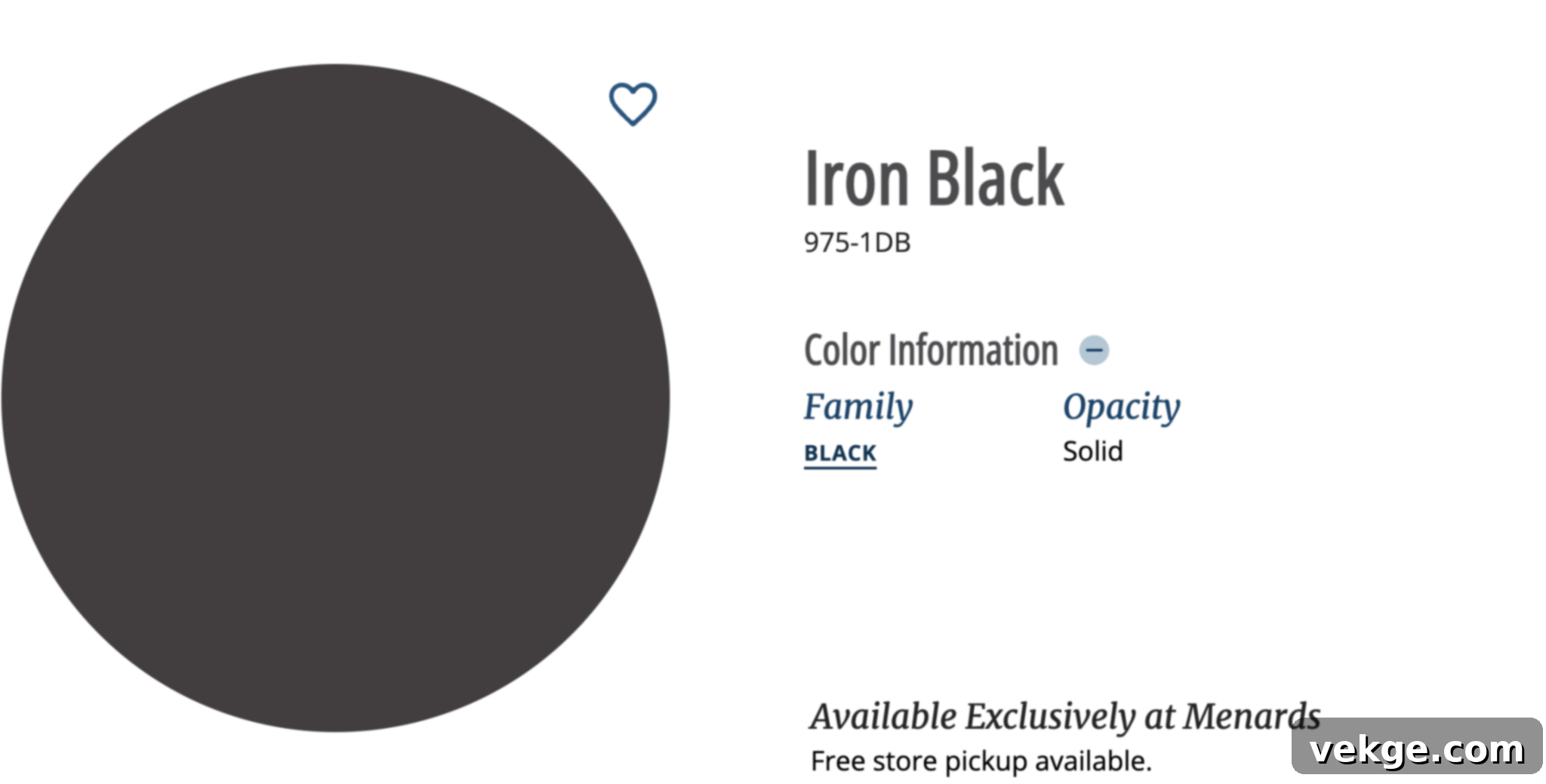
Dutch Boy Iron Black is an excellent moisture-resistant option, making it particularly well-suited for spaces prone to humidity or potential spills, such as kitchens and bathrooms.
Features
- Satin Finish: Provides a perfect balance between matte and glossy, offering a subtle sheen that is both elegant and practical.
- Moisture-Resistant Properties: Specifically formulated to stand up to damp conditions, making it ideal for environments where moisture is a concern.
- Easy-to-Clean Surface: Its durable finish is designed to withstand everyday wear and tear, making routine cleaning simple and effective.
Best For: Practical, stylish updates in functional spaces like kitchens, bathrooms, and utility rooms where durability and moisture resistance are key. View Details for Dutch Boy Iron Black.
10. Clare Blackest
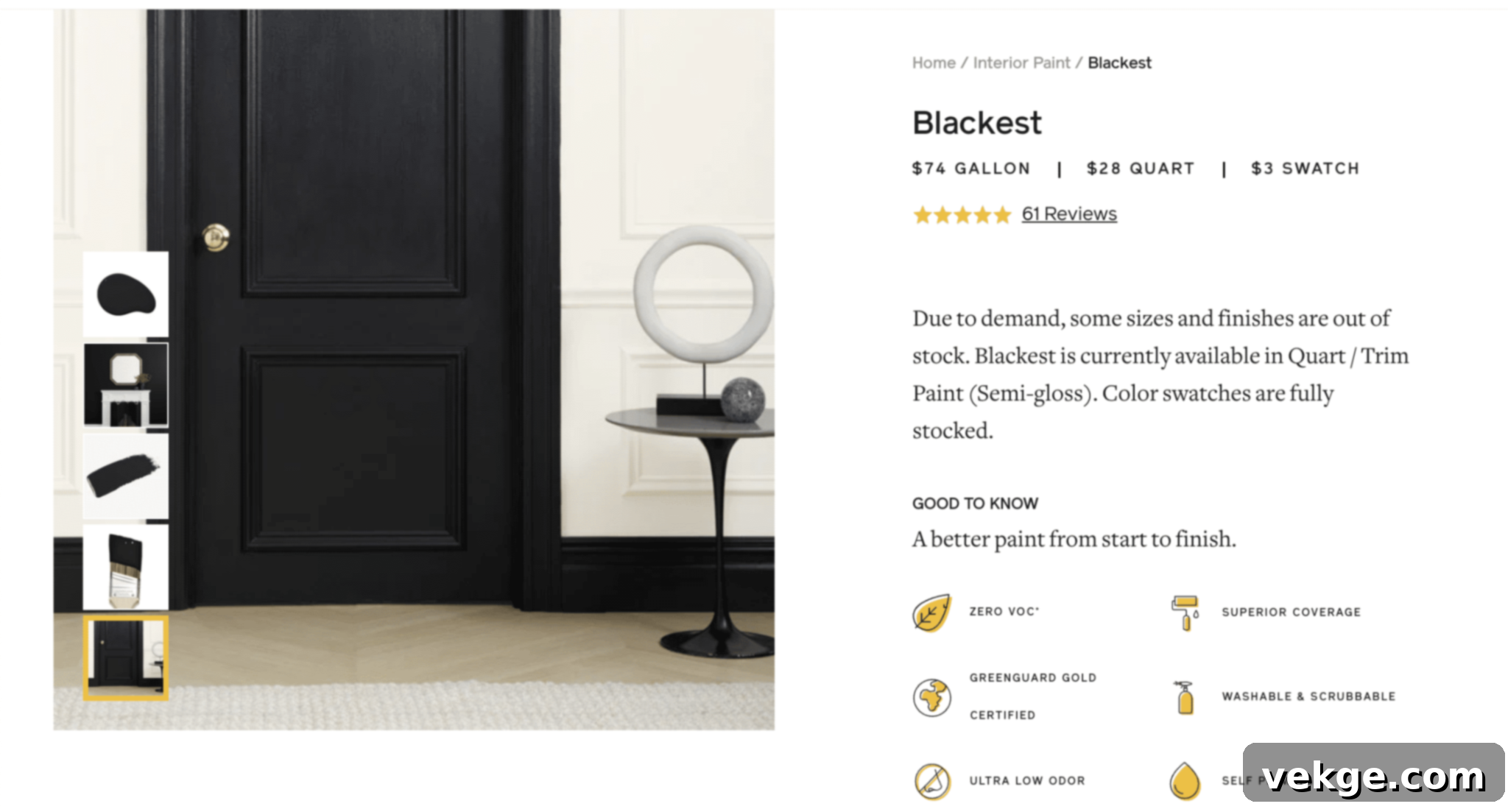
Clare Blackest is an eco-friendly and ultra-pigmented choice, delivering a deep, pure black that is perfect for achieving a sophisticated and modern look with a conscience.
Features
- Ultra-Rich Black: Formulated for maximum pigment, it offers a remarkably pure black with virtually no undertones, ensuring a truly profound visual impact.
- Non-Toxic, Low-VOC: Prioritizes indoor air quality with a non-toxic, low-VOC formula, making it a healthier choice for your home and family.
- Exceptional Coverage: Its high-pigment load means fewer coats are required to achieve full, opaque coverage, saving time and effort.
Best For: Eco-conscious homes, minimalist designs, or sleek, modern interiors that benefit from a deep, unadulterated black. Purchase Clare Blackest Now.
11. Zinsser Perma-Black
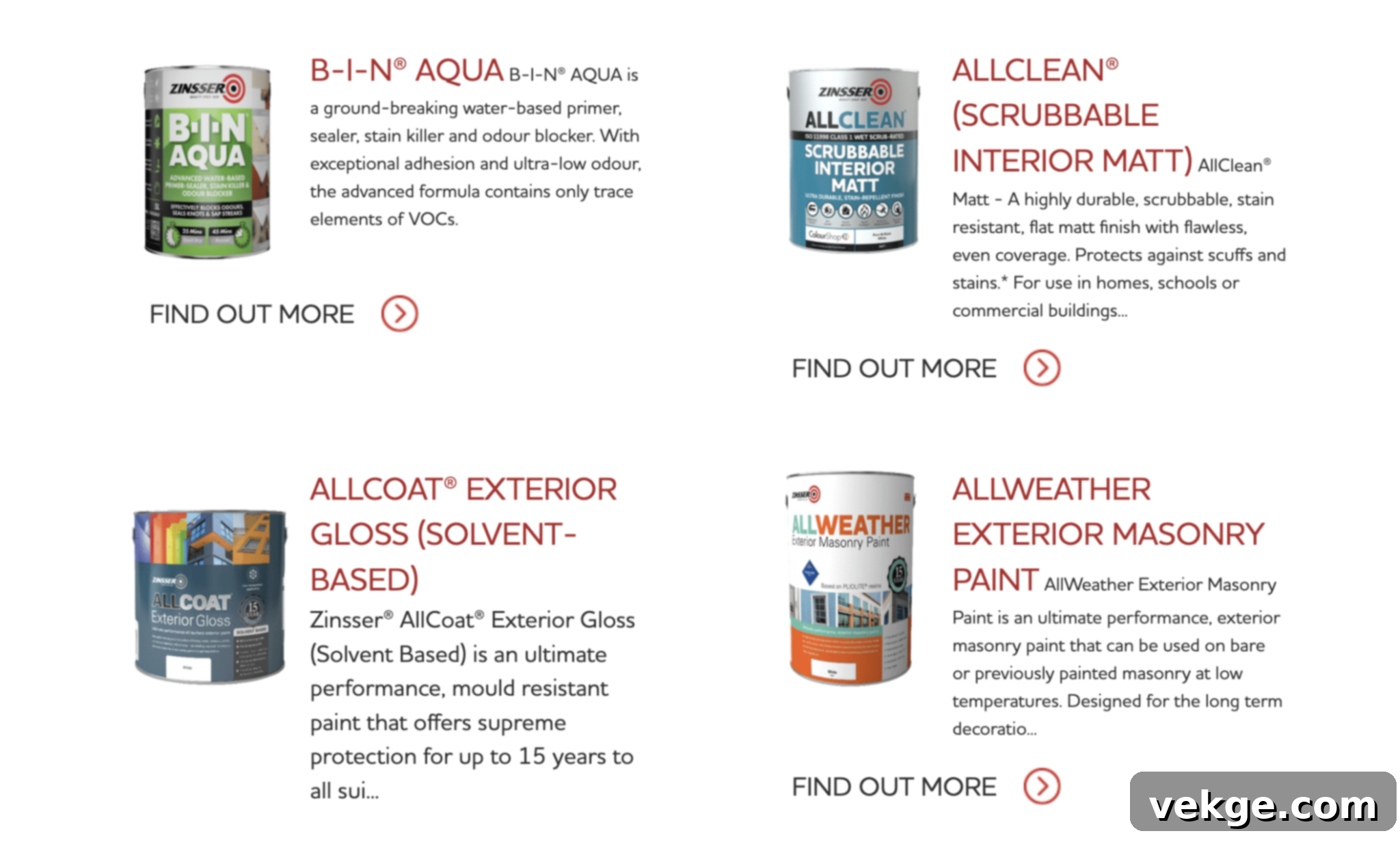
Zinsser Perma-Black is a convenient paint-and-primer in one, specifically engineered for challenging surfaces where superior adhesion and protection are required.
Features
- Excellent Adhesion: Boasts superior bonding properties, adhering effectively to a wide range of surfaces including laminate, wood, metal, and previously painted surfaces.
- Mold & Mildew Resistant: Its protective formula makes it ideal for humid environments, actively resisting the growth of mold and mildew.
- Semi-Gloss Finish: Offers a subtle yet practical sheen that is easy to clean and maintains a fresh look, perfect for functional areas.
Best For: Bathrooms, kitchens, basements, or any areas with challenging surfaces or high humidity where robust adhesion and protective properties are crucial. Look at Zinsser’s Complete Collection.
12. Clark+Kensington Black Satin

Clark+Kensington Black Satin is a premium paint renowned for its sleek, rich finish and excellent durability, making it a reliable choice for interior doors.
Features
- Stain-Blocking & Moisture-Resistant: Formulated with advanced properties that resist stains and moisture, enhancing its longevity and ease of maintenance.
- Exceptional Coverage: Delivers superior coverage with minimal coats, ensuring a smooth, consistent, and deeply colored finish.
- Satin Finish: Provides a subtle sheen that balances elegance with practicality, reflecting just enough light to add depth without being overly glossy.
Best For: Elegant, understated looks in functional spaces, offering a refined appearance that stands up to daily use. Find Clark+Kensington Black Satin Here.
13. Glidden Onyx Black
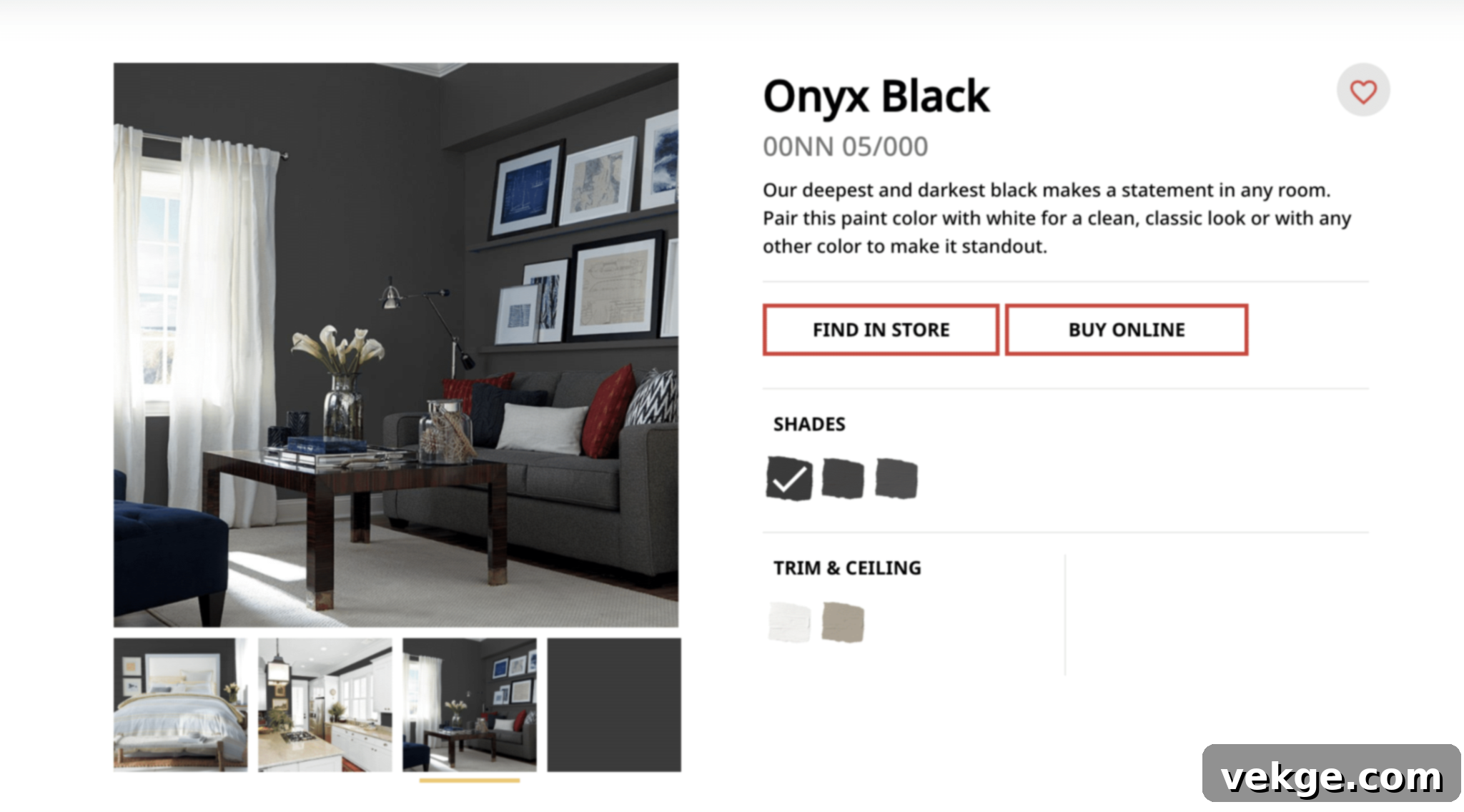
Glidden Onyx Black offers an affordable yet high-performing semi-gloss black that skillfully balances style with crucial functionality, perfect for busy households.
Features
- Semi-Gloss Finish: This popular finish provides a pleasant sheen that makes the door easy to clean and highly resistant to marks and scuffs.
- Reliable Coverage: Delivers good, consistent coverage with minimal effort and at a cost-effective price point, making it an excellent value.
- Good Durability: Designed to withstand the rigors of everyday use, ensuring your black doors maintain their appealing look over time.
Best For: Cost-effective updates in busy households where durability, ease of cleaning, and an attractive finish are all important considerations. Shop Glidden Onyx Black Now.
Top Considerations When Painting Interior Doors Black
Having painted countless doors black throughout my career, I’ve gathered valuable insights that can save you significant time, money, and frustration. Here are the essential considerations to ensure your black doors turn out perfectly.
1. Pick the Right Black for Your Space
It’s a common misconception that all black paints are the same – I learned this the hard way! Blacks have subtle undertones that can drastically change their appearance. Some blacks lean cool with hints of blue or purple, while others are warm with brown or red undertones. A “true” black typically has no discernible undertones. Always test your chosen paint on a sample board or a discreet section of your door. Observe it in both natural daylight and evening artificial light; you’ll be surprised how different it can look throughout the day.
2. Check Your Door Material
The material of your door dictates the specific preparation and type of paint or primer required for optimal adhesion and finish:
- Wood Doors: Always sand lightly to create a smooth surface for adhesion, then use a high-quality wood primer.
- Metal Doors: Look for paints with rust-inhibiting properties and use a metal-specific primer to prevent corrosion and ensure strong bonding.
- Fiberglass Doors: These require thorough cleaning and the application of a bonding primer to help the paint adhere properly to the smooth surface.
3. Understand Your Room’s Lighting
This is a crucial point many people overlook: lighting significantly alters how black paint is perceived. The same black can appear softer or harsher depending on the light source and intensity:
- Near Windows: Natural light can make black appear less intense, sometimes revealing subtle undertones.
- Under Ceiling Lights: Artificial light, especially warm or cool LED, can influence the perceived shade of black.
- In Shadowy Corners: Black will appear deepest and most dramatic in less-lit areas.
- At Different Times of Day: Observe how the color shifts from morning to afternoon to evening.
4. Match Your Home’s Architectural Style
While black doors are incredibly versatile, the choice of finish can greatly enhance or detract from your home’s overall aesthetic:
- Matte Black: Excellent for modern, minimalist, or industrial homes, providing a sophisticated, no-shine look.
- Satin Black: The most versatile option, working beautifully in almost any space from transitional to traditional, offering a soft, subtle sheen.
- Semi-Gloss Black: Often chosen for traditional, classic, or formal homes, this finish offers a noticeable sheen and is very durable.
- High-Gloss Black: Ideal for ultra-modern, art deco, or highly formal spaces where a dramatic, mirror-like reflection is desired.
5. Consider High-Traffic Areas
I’ve seen beautiful paint jobs quickly ruined in busy areas. For doors that experience frequent use and contact (e.g., kitchen, kids’ rooms, main entry):
- Choose a paint explicitly labeled as scuff-resistant or highly durable.
- Opt for a finish that is easy to clean, such as satin or semi-gloss, as matte finishes can be harder to wipe down without leaving marks.
- Apply an extra coat of paint for enhanced protection against wear and tear.
6. Pay Attention to Weather and Environment
The ambient conditions during painting significantly impact how paint dries and cures. I’ve found these tips crucial:
- Temperature: Paint when the indoor temperature is consistently between 60-80°F (15-27°C) for optimal drying.
- Airflow: Keep windows open slightly for good ventilation, but avoid strong drafts that can cause uneven drying.
- Humidity: Avoid painting on very humid days. High humidity can prolong drying times and lead to drips or an uneven finish.
Comparing Glossy vs. Matte vs. Satin Finishes for Black Doors
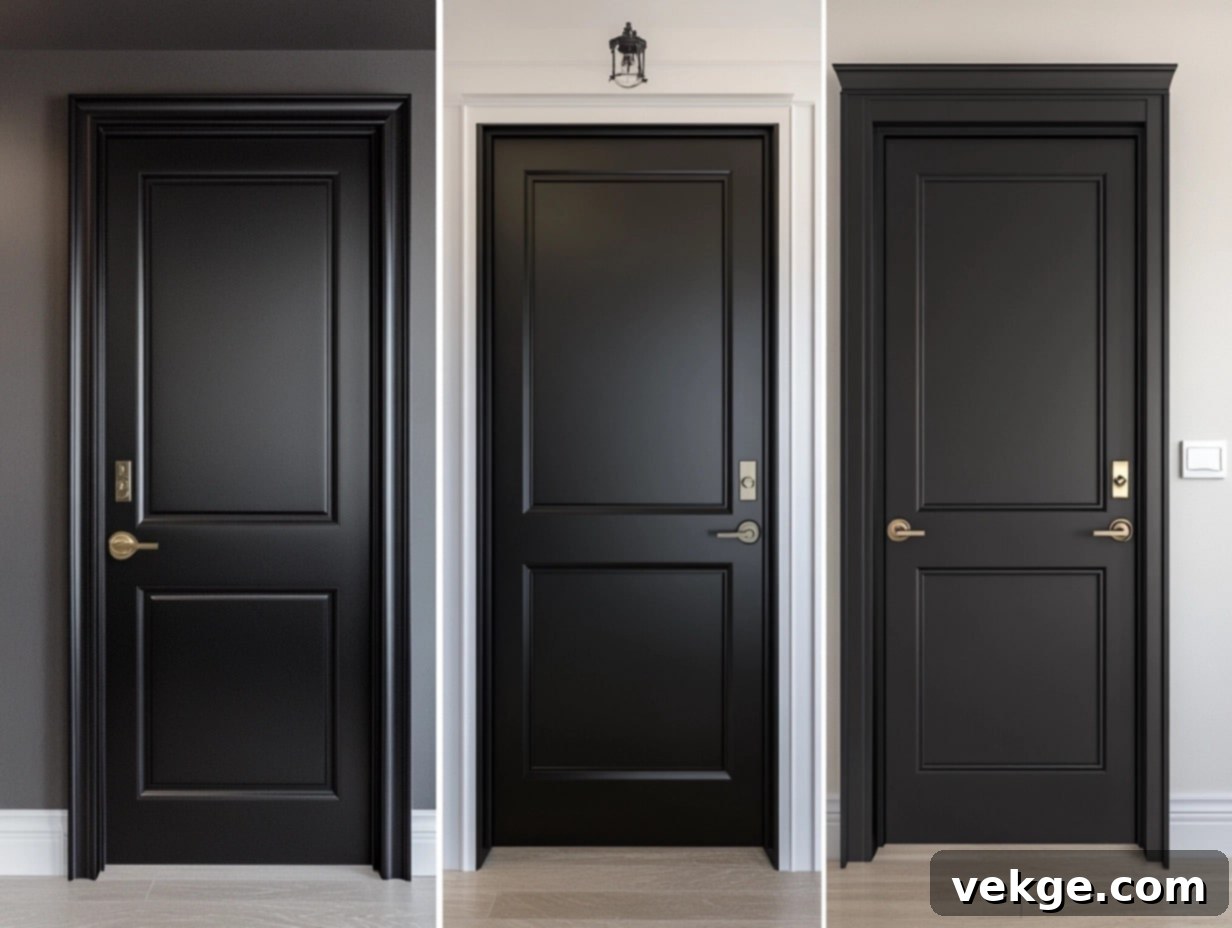
When you decide to paint your interior doors black, the chosen finish is just as pivotal as the shade itself. Glossy, matte, and satin finishes each create distinct visual effects and offer different levels of practicality and durability. Understanding these differences will help you select the ideal finish to match your aesthetic goals and lifestyle needs.
| Finish | Characteristics | Pros | Cons | Best For |
|---|---|---|---|---|
| Glossy (High-Gloss) | Highly reflective, mirror-like surface with maximum shine. | – Extremely easy to clean and very durable. – Adds a bold, modern, and luxurious feel. – Creates a striking, high-impact statement. |
– Highly prone to showing fingerprints, smudges, and dust. – Magnifies any surface imperfections (dents, scratches) significantly. – Requires near-perfect surface preparation. |
– Modern, contemporary, or Art Deco styles. – High-traffic areas where durability and easy cleaning are paramount, and a bold look is desired (e.g., kitchen, hallways, formal dining). |
| Matte (Flat) | Smooth, non-reflective finish with no shine. Absorbs light. | – Excellent at hiding imperfections, bumps, or flaws on older doors. – Creates a sophisticated, bold, and dramatic yet understated look. – Soft and contemporary, providing a luxurious, velvety appearance. |
– More challenging to clean than shinier finishes; can scuff or mark more easily. – Less durable in high-use areas; can show wear over time. – Can be harder to touch up seamlessly. |
– Low-traffic areas like bedrooms or studies. – Rustic, farmhouse, industrial, or vintage decor styles where a soft, unpolished look is preferred. |
| Satin | A refined, soft sheen that sits gracefully between matte and glossy. Light-reflective but not mirror-like. | – Offers subtle elegance and a sophisticated glow. – Considerably easier to clean and more durable than matte. – Highly versatile, complementing almost any decor style. – Hides minor imperfections better than glossy finishes. |
– Can slightly highlight more significant imperfections compared to matte. – Less dramatic than high-gloss but also less ‘hidden’ than matte. |
– An ideal all-purpose finish for nearly every room. – Works exceptionally well in living rooms, entryways, bathrooms, and children’s rooms due to its balance of style and practicality. |
Quick Finish Selection Guide
To help you make a swift decision, here’s a quick guide based on common scenarios:
| Your Situation | Best Finish Choice |
|---|---|
| Busy household with kids and pets | Satin or Semi-Gloss (for durability and easy cleaning) |
| Formal dining room or an elegant study | High-Gloss (for drama and luxury) or Satin (for refined elegance) |
| Bathroom or laundry room door (high humidity) | Satin or Semi-Gloss (for moisture resistance and cleanability) |
| Bedroom door (low traffic, desire for softness) | Matte or Satin (for sophisticated, calming aesthetics) |
| Older door with minor surface flaws or imperfections | Matte or Satin (to effectively mask blemishes) |
| Modern condo or minimalist apartment | High-Gloss (for sleekness) or Matte (for contemporary sophistication) |
| Farmhouse or rustic style home | Matte (for a soft, authentic, and charming look) |
Ultimately, the finish you choose should not only align with your personal style but also be capable of withstanding the daily wear and tear of its specific location. So, consider your needs carefully—what’s your perfect pick?
Having personally painted thousands of doors, one truth consistently stands out: meticulous preparation is the undisputed secret to impeccable results. Allow me to share my proven, step-by-step process for preparing your doors for a flawless black paint application.
Step-by-Step Door Prep Guide for a Flawless Black Finish
Proper preparation is arguably more important than the painting itself, especially when working with a bold color like black. Skipping steps here can lead to uneven finishes, chipping, and a less-than-professional appearance. Follow these steps for the best results:
1. Remove the Door and Hardware (Recommended)
- While you can paint a door while it’s hanging, removing it completely and laying it flat on sawhorses or a protected surface makes the process significantly easier and helps prevent drips.
- Carefully remove all hardware, including doorknobs, hinges, and any existing locks. This ensures a clean, professional finish without needing to awkwardly paint around them. Store hardware safely.
2. Thoroughly Clean the Surface
- Using a damp cloth or a mild all-purpose cleaner (like a diluted dish soap solution), meticulously clean the entire door surface. Remove all traces of dirt, grease, grime, and fingerprints. Black paint will highlight any imperfections or dirt left behind.
- Rinse with a clean, damp cloth and allow the door to dry completely before proceeding. Any residual moisture can affect paint adhesion.
3. Sand the Door for Optimal Adhesion
- Lightly sand the entire door surface using medium-grit sandpaper (around 120-150 grit) to create a “tooth” for the primer and paint to adhere to. This is crucial for durability.
- Pay extra attention to any areas with old, peeling paint, rough spots, or dents, feathering out the edges. If the door has a glossy finish, sanding is essential to dull the shine.
- After initial sanding, use fine-grit sandpaper (220 grit or higher) for a final pass to ensure a smooth, ready-to-paint surface.
- Thoroughly wipe away all sanding dust using a tack cloth or a slightly damp microfiber cloth. Dust is the enemy of a smooth finish.
4. Fill Any Gaps or Cracks
- Inspect the door for any holes (from removed hardware, old hooks), cracks, or significant dents.
- Use a high-quality wood filler (for wood doors) or appropriate spackle to fill these imperfections. Apply with a putty knife, ensuring it’s flush with the surface.
- Allow the filler to dry completely according to manufacturer instructions, then sand the filled areas smooth with fine-grit sandpaper. Wipe away dust.
5. Prime the Door (Non-Negotiable for Black Paint)
- Applying a quality primer is absolutely essential when painting doors black, especially if you’re painting over a dark color, a glossy surface, or a raw material.
- Primer creates a uniform base, enhances paint adhesion, blocks stains, prevents old colors from bleeding through (even light colors can affect black’s purity), and reduces the number of paint coats needed for full coverage.
- Apply one to two thin, even coats of a good quality primer (a gray-tinted primer can sometimes help black paint achieve full coverage faster). Allow each coat to dry thoroughly.
6. Mask Off Areas (if door is still hanging)
- If you chose to paint the door while it’s still hanging, use high-quality painter’s tape to meticulously cover hinges, door jambs, and any other areas you don’t want painted. A clean tape line is vital for a professional look.
Tools You’ll Need for Door Prep:
- Sandpaper: Medium (120-150 grit) for initial smoothing and fine (220+ grit) for a super-smooth finish.
- Tack Cloth or Microfiber Cloth: Essential for removing all dust particles.
- Painter’s Tape: For crisp lines if not removing the door.
- Screwdriver: To easily remove and reattach door hardware.
- Wood Filler and Putty Knife: For repairing dents, holes, or cracks.
- Primer and Paintbrush/Roller: A high-quality synthetic brush for trim and details, and a small foam roller for smooth, even coverage on flat panels.
- Drop Cloths/Plastic Sheeting: To protect your floors and work surfaces.
- Sawhorses: Highly recommended for painting the door horizontally.
Expert Insights: Maintaining Your Black Interior Doors
Once your black doors are beautifully painted, the next step is ensuring they retain their stunning appearance over time. Proper cleaning and long-term maintenance are key to preserving their sleek, polished look.
How to Clean Your Black Doors Effectively
Cleaning black doors is straightforward, but it requires a gentle approach to prevent damage to the paint finish. Harsh cleaning products can dull the color, leave streaks, or even strip the paint, so always stick to gentle, non-abrasive methods:
1. Dust Regularly
- The simplest and most effective step is regular dusting. Use a soft microfiber cloth, a feather duster, or a dusting mitt to gently wipe away dust and cobwebs before they accumulate. This prevents dust from settling into a noticeable layer, which can dull the black.
2. Wipe with Mild Soap Solution
- For a deeper clean, mix a very small amount of mild dish soap (e.g., Dawn) with warm water. You want a barely sudsy solution.
- Dip a soft, clean, damp cloth into the solution, wring it out thoroughly so it’s not dripping, and gently wipe down the door surface. Focus on wiping, not scrubbing, to avoid damaging the paint.
- Avoid soaking the door or allowing water to sit on the surface, especially around edges or hardware, as this can lead to swelling or water damage.
3. Dry Thoroughly Immediately
- After wiping with the soap solution, immediately use a separate, clean, dry microfiber cloth to thoroughly dry the door. This step is critical to prevent water spots, streaks, or residue from marring the black finish.
Products to Use and Avoid for Cleaning Black Doors
Being mindful of your cleaning products will extend the life and beauty of your black doors:
Use:
- Mild Dish Soap: Gentle and effective for cutting through grime without harsh chemicals.
- Microfiber Cloths: Soft, highly absorbent, and lint-free, they are ideal for gentle cleaning and streak-free drying.
- Non-Abrasive Sponges: If you need a bit more scrubbing power for a stubborn mark, opt for a soft, non-scratch sponge.
Avoid:
- Harsh Chemicals: Bleach, ammonia-based cleaners, abrasive cleansers, or acidic cleaners can damage paint finishes, causing discoloration or dulling.
- Abrasive Pads/Brushes: Steel wool, rough scrubbers, or stiff brushes can easily scratch and permanently damage the paint surface, especially on matte or satin finishes.
- Oil-Based Cleaners or Waxes: While some might think these add shine, they can often leave greasy residues, attract dust, and create unsightly streaks on black paint.
Long-Term Maintenance Tips for Enduring Beauty
Black paint is inherently durable, but consistent, thoughtful care will ensure your doors remain flawless for many years:
- Prevent Chipping and Dents: Install rubber door stoppers or wall protectors behind doors to prevent accidental bumps against walls or furniture. This is especially important in high-traffic areas where doors are frequently opened and closed with force.
- Keep Touch-Up Paint Handy: Always keep a small, clearly labeled container of the original paint used for your doors. This allows for quick, seamless touch-ups of minor chips or scratches, blending perfectly with the existing finish.
- Protect from Direct Sunlight: If your black doors are positioned in areas that receive direct, prolonged sunlight, consider adding window treatments (blinds, curtains) to block intense UV rays. Direct sunlight can cause paint to fade over time, especially with darker colors.
- Handle with Care: Gently encourage all household members to avoid slamming doors. Repeated impact can not only damage the door frame but also cause the paint to crack, chip, or peel along the edges.
Common Mistakes to Avoid When Painting Doors Black
Having witnessed and corrected countless DIY painting mishaps, I’ve compiled a list of the most frequent errors people make when painting doors black. Avoiding these will save you immense frustration and ensure a professional, lasting finish.
1. Skipping the Primer Step Entirely
This is, without a doubt, the most common and detrimental mistake. Primer is not an optional step, especially with black paint. It is absolutely essential because it:
- Creates a Smooth, Uniform Base: Primer fills tiny imperfections and creates an even surface, which is critical for black paint that highlights every flaw.
- Prevents Old Colors from Bleeding Through: Even light colors can subtly alter the hue of black if not properly sealed with primer.
- Enhances Adhesion and Durability: Primer ensures the paint adheres strongly to the door, preventing premature peeling and chipping, especially in high-traffic areas.
- Reduces Number of Paint Coats: A good primer (especially a tinted gray primer) significantly reduces the number of black paint coats required, saving time and money.
Always take the time to apply one to two thin, even coats of a high-quality primer. It’s an investment that pays off tenfold in the final result and longevity of your paint job.
2. Using the Wrong Tools or Application Techniques
The tools and methods you use have a direct impact on the quality of your finish:
- Choose High-Quality Rollers: For large, flat areas of the door, use a high-quality, short-nap foam roller or a fine-finish roller. This minimizes texture and ensures a smooth, even application, which is crucial for black paint that shows brush strokes easily.
- Utilize Angled Brushes for Details: For panel insets, edges, and trim work, use a good quality angled brush. This allows for precision and control.
- Avoid Overloading Tools: Resist the urge to load your brush or roller with too much paint. Apply paint in thin, even coats. Thick coats are prone to drips, uneven drying, and an “orange peel” texture. Patience is key; multiple thin coats are always better than one thick one.
3. Selecting an Inappropriate Finish for the Location
As discussed, the paint finish dramatically impacts both the aesthetic and functional aspects of your black doors:
- High-Gloss: While bold and elegant, it ruthlessly highlights every single flaw, dust particle, and fingerprint. Best for perfectly smooth doors in low-touch, high-impact areas.
- Matte: Excellent for hiding imperfections and creating a sophisticated look, but it is notoriously difficult to clean and less durable against scuffs and marks. Not ideal for busy areas.
- Satin or Semi-Gloss: These are often the most practical and versatile choices. They offer a good balance of durability, ease of cleaning, and a refined appearance without being overly reflective or too flat. They are forgiving enough for everyday use yet sophisticated.
Always pick a finish based on your door’s specific location, its expected usage, and the level of durability and ease of maintenance you require.
Complementary Hardware for a Black Door: The Finishing Touch
Once your interior doors are painted a striking black, selecting the right hardware is the crucial final step. The doorknobs, hinges, and locks are more than just functional components; they are your door’s accessories, capable of dramatically influencing its overall aesthetic and tying it into your home’s design narrative.
Why Hardware Matters
The right hardware can truly complete the look of your black doors, acting as the jewelry that enhances their beauty and functionality:
- Elevate the Overall Design: High-quality, thoughtfully chosen hardware can transform a simple black door into a sophisticated design element.
- Add Texture and Shine: Metals offer a tactile and visual contrast to the flat or satin black of the door, introducing another layer of interest.
- Tie the Door to the Rest of Your Space: Matching hardware finishes to other metallic accents in the room (light fixtures, cabinet pulls) creates a cohesive and harmonious interior.
Popular Hardware Finishes to Pair with Black Doors
Certain metal finishes particularly shine when contrasted or complemented with black:
1. Brass (Polished, Brushed, or Antique)
- Characteristics: Brass offers a warm, inviting glow that contrasts beautifully with the starkness of black. Polished brass is bright and reflective, while brushed or antique brass has a softer, more subdued luster.
- Ideal For: It works exceptionally well in classic, traditional, vintage, or even some transitional-style homes, adding a touch of timeless elegance.
- Design Tip: Consider brass if you have other warm metal accents (like gold picture frames, bronze light fixtures) elsewhere in your space to create a harmonious flow.
2. Chrome or Polished Nickel
- Characteristics: These finishes are sleek, shiny, and highly reflective, exuding a polished and contemporary vibe. Polished nickel offers a slightly warmer, richer tone than chrome.
- Ideal For: Perfect for modern, minimalist, Scandinavian, or industrial designs where clean lines and a crisp aesthetic are paramount.
- Design Tip: They pair wonderfully with cool tones, crisp white decor, or gray palettes, providing a bright contrast against the dark door.
3. Matte Black
- Characteristics: Opting for matte black hardware creates a monochromatic, understated, and incredibly cohesive look. It provides depth without introducing a contrasting color.
- Ideal For: Great for industrial, contemporary, or highly minimalist spaces where a seamless, bold, and sophisticated statement is desired.
- Design Tip: This choice makes the hardware feel like an integrated part of the door itself, offering a subtle textural difference rather than a color contrast.
4. Bronze or Oil-Rubbed Bronze
- Characteristics: These finishes offer a rich, dark, and often rustic look, with warm undertones. Oil-rubbed bronze typically has a living finish that can change over time.
- Ideal For: Suited for traditional, craftsman, Tuscan, or rustic farmhouse styles, adding an aged, substantial feel.
- Design Tip: Provides a subtle, deeper contrast to black than lighter metals, often blending harmoniously for a more subdued elegance.
Style Suggestions
- For a Modern Look: Pair your black door with sleek chrome or polished nickel handles and minimalist hinges. The bright, reflective shine adds a dynamic contrast without overwhelming the modern aesthetic.
- For a Classic & Timeless Vibe: Choose elegant antique brass or brushed bronze knobs and matching hardware. The warmth of these metals complements black beautifully, evoking a sense of history and sophistication.
- For an Eclectic or Unique Feel: Don’t be afraid to mix metals! For example, combine matte black hinges with elegant brass or even copper handles. This approach adds character and depth without necessarily clashing, as black provides a strong, unifying base.
Ultimately, the best hardware choice enhances your door’s beauty and fits seamlessly into your home’s overall design. Trust your intuition and consider what complements the existing finishes and desired mood of your space.
Conclusion: Embrace the Power of Black Interior Doors
Black interior doors are more than just a passing trend; they are a timeless design choice with the power to profoundly change the look and feel of your entire home. By adding depth, contrast, and sophistication, they elevate ordinary spaces into captivating interiors. This comprehensive guide has equipped you with the knowledge to make informed decisions, covering everything from selecting the best black paints to proper preparation techniques and smart ways to maintain your doors, ensuring they look fresh and stunning for years to come.
Remember these key takeaways: the right paint choice and meticulous preparation are the twin pillars of a successful black door project. Whether you lean towards Benjamin Moore’s velvety Black Beauty for its luxurious depth, Sherwin-Williams’ versatile Tricorn Black for its pure hue, or a more budget-friendly yet durable option, focusing on quality will always yield the best results. Your doors, and indeed your entire home, will thank you for the attention to detail.
If you’re still feeling unsure, I encourage you to start small. Select one door, perhaps in a less prominent area. Test your chosen paint, select hardware you love, and observe how this single transformation impacts the space. Once you witness the dramatic and elegant results, you’ll undoubtedly feel inspired to transform more doors throughout your home.
Do you have further questions or need more personalized advice? Feel free to drop them in the comments section below. And if you’ve already painted your doors black, we’d absolutely love to see them! Share a photo and tell us about your experience—your insights could be invaluable to others embarking on their own black door journey.
Frequently Asked Questions About Black Interior Doors
Can I Use Matte Black Paint on High-Traffic Doors?
While matte black offers a stunning, sophisticated look, it is generally not ideal for high-traffic doors. Its flat finish is more prone to showing scuffs, fingerprints, and is harder to clean without leaving marks. For doors that see frequent use, a more durable and easily washable finish like satin or semi-gloss is a much better and more practical option.
What’s the Easiest Way to Clean Black Interior Doors?
The easiest and safest way to clean black interior doors is with a damp microfiber cloth and a very mild solution of dish soap and warm water. Wring out the cloth thoroughly to avoid excess moisture. Always follow up immediately by drying the door with a clean, dry microfiber cloth to prevent water spots or streaks. Avoid harsh chemicals, abrasive pads, or oil-based cleaners, as these can damage the paint finish.
How Do I Match Hardware with Black Doors?
Popular hardware finishes that beautifully complement black doors include brass (for warmth and classic elegance), chrome or polished nickel (for a sleek, modern look), matte black (for a cohesive, monochromatic, and industrial vibe), and bronze (for rustic or traditional charm). The best choice depends on your room’s overall style and the other metallic accents present in your space. Consider what aesthetic you want to achieve – a bold contrast or a seamless integration.
Do Black Doors Make a Room Feel Smaller?
Contrary to popular belief, black doors often do not make a room feel smaller. Instead, they can provide a strong visual anchor and definition, making a space feel more sophisticated and intentional. Against light walls, they create striking contrast and act as focal points. In some cases, a high-gloss black can even reflect light, adding a sense of depth. The perception of size is more influenced by the overall wall color, natural light, and furniture arrangement than by the doors alone.
Is Primer Absolutely Necessary for Black Paint?
Yes, primer is absolutely necessary when painting interior doors black. It provides a crucial foundation for several reasons: it ensures excellent adhesion of the topcoat, prevents underlying colors or stains from bleeding through, creates a smooth and uniform surface (which is essential for black paint that highlights imperfections), and often reduces the number of black paint coats required. Skipping primer can lead to poor adhesion, uneven color, and a less durable finish.
